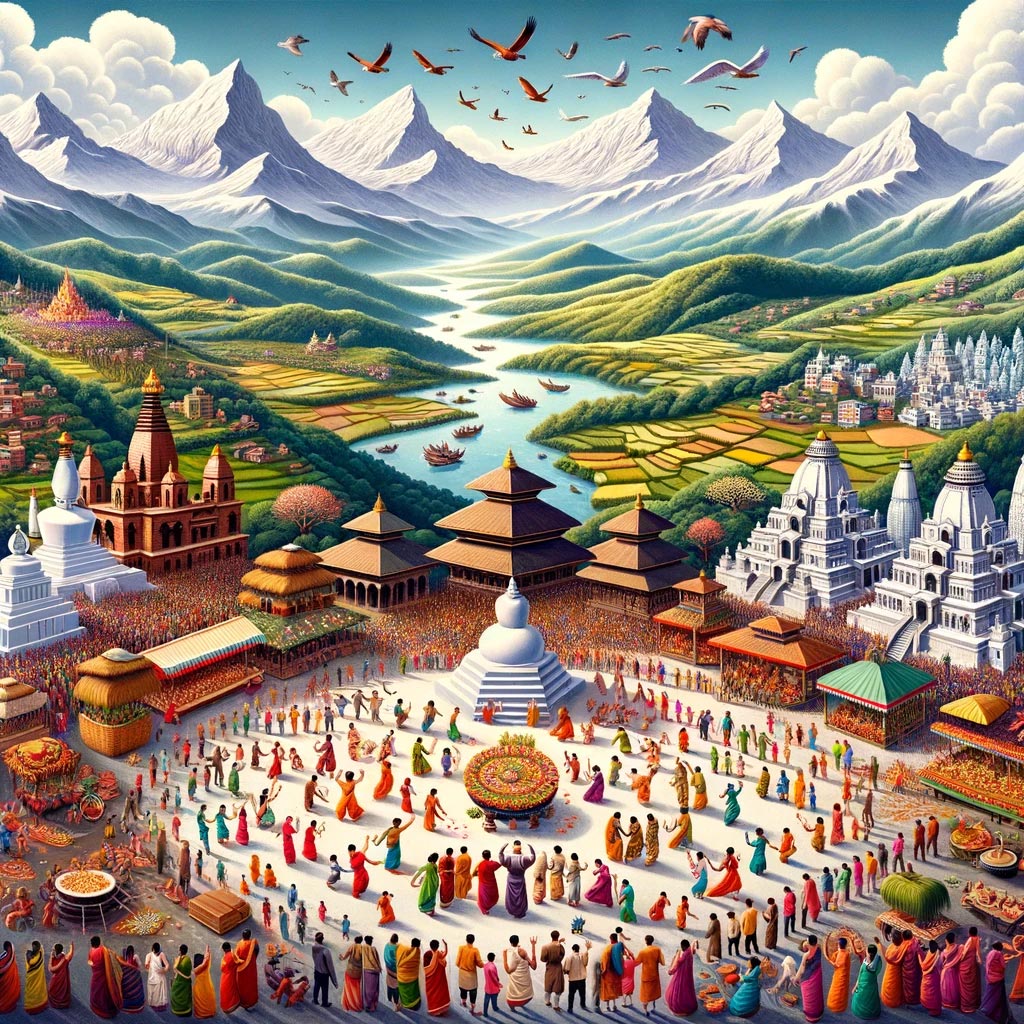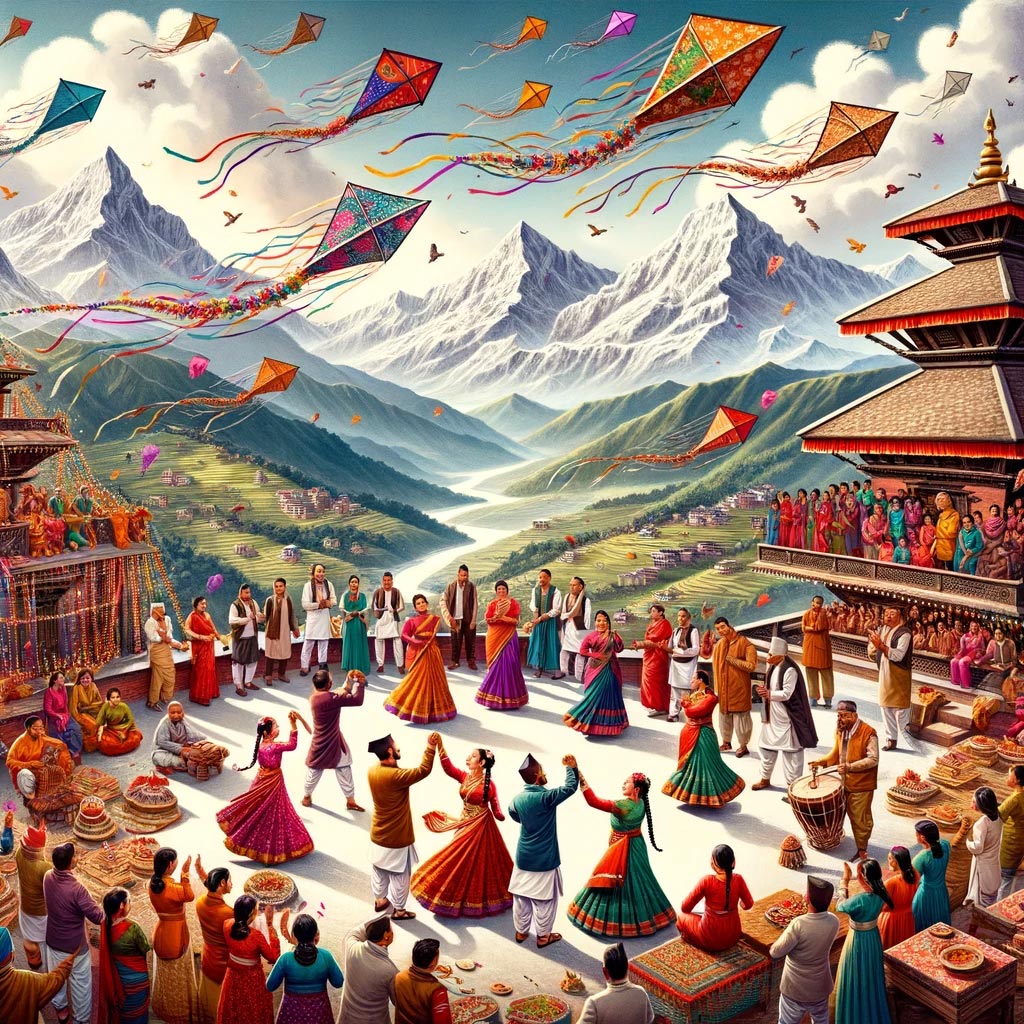
Family Rituals of Dashain, Tihar & Chhath in Nepal
In the heart of Nepal's vibrant culture lie the deeply rooted traditions of Dashain, Tihar, and Chhath festivals. This article delves into the historical origins, religious significance, and cherished family rituals associated with each celebration. It further explores the evolution of these traditions over time, reflecting societal shifts and technological advancements. By highlighting regional variations, the article offers a panoramic view of how diverse areas of Nepal uniquely interpret and celebrate these festivals, weaving a tapestry of unity in diversity.
Historical Origins of Dashain, Tihar, and Chhath in Nepal
Dashain: The Celebration of Victory
Hailing from ancient times, Dashain marks the victory of Goddess Durga over the demon Mahishasura. According to Tek Bahadur Shrestha's "Culture and Customs of Nepal", the festival symbolizes the triumph of good over evil.
Tihar: The Festival of Lights
Tihar, akin to the Indian festival of Diwali, is centered around the veneration of animals and the goddess of wealth, Laxmi. "Nepal – Festivals and Rituals" by Ram Raj Prasad details how Tihar is celebrated over five days, each dedicated to different animals and gods.
Chhath: Sun Worship
Unique to the Mithila region and parts of Nepal, Chhath involves the worship of the Sun God. This festival's significance lies in its connection to nature and the sun, revered as a source of healing and prosperity.
Religious and Cultural Significance
Dashain, Tihar, and Chhath are not mere festivals; they reflect the Nepalese culture and values. Each festival represents:
- Faith & Devotion: The unwavering devotion of Nepali people to their gods and the fervor with which they practice their rituals.
- Unity & Harmony: Bringing families together, these festivals strengthen community bonds.
- Cultural Preservation: Acting as the vessels of Nepali traditions, they ensure that the rich culture and customs are passed down through generations.
Main Rituals and Traditions
Dashain Family Rituals in Nepal
- Sowing Barley Seeds: This symbolizes prosperity and is the first step to Dashain.
- Ghatasthapana: A pot is filled with water, symbolizing Goddess Durga. Barley seeds are sown around this pot.
- Receiving Tika: Elders put a mixture of yogurt, rice, and vermillion on the foreheads of younger family members, blessing them with longevity and prosperity.
Tihar Traditions and Significance
- Worshipping Crows and Dogs: These animals are venerated for their respective roles in Hindu mythology.
- Laxmi Puja: Devotees clean their homes and light candles to welcome Goddess Laxmi.
- Bhai Tika: Sisters apply Tika to their brothers, praying for their long life.
Chhath Puja Rituals in Nepali Culture
- Ritualistic Fasting: Devotees fast, even abstaining from water.
- Sunset and Sunrise Worship: The sun is worshipped during these times for its life-giving energy.

Typical Foods and Attire
Dashain
- Food: Mutton, rice, lentils, and vegetables.
- Attire: New clothes, typically traditional Nepali wear.
Tihar
- Food: Sel roti (traditional homemade ring-shaped rice bread), fruits, and nuts.
- Attire: Bright and colorful outfits.
Chhath
- Food: Thekuwa (a type of sweet bread) and fruits.
- Attire: Traditional wear, predominantly in yellow.
Role and Participation of Family Members
In all three festivals, families come together, strengthening their bonds. Elders lead the rituals, ensuring Nepali traditions are passed down. Women often take on significant roles, preparing feasts and leading certain pujas. Children revel in the festivities, imbibing the culture.
Evolution of Traditions
When we speak of traditions, especially in the context of deeply-rooted cultures such as Nepal's, we envision time-tested practices and rituals that have been passed down through generations. However, traditions are not static; they evolve, reflecting the changing times, societal shifts, and even technological advancements. The festivals of Dashain, Tihar, and Chhath in Nepal, while maintaining their core essence, have witnessed subtle and significant changes over the years.
Dashain: Merging the Old with the New
-
Cards and Greetings: There was a time when Dashain cards, lovingly chosen and posted, were eagerly awaited by recipients. With the digital age, while the sentiment of wishing remains, the medium has transitioned to electronic cards, texts, and online greetings.
-
Gifts and Blessings: Previously, elders predominantly gave blessings. Today, there's a blend of the traditional 'aashirwad' with the gifting of modern gadgets, books, and other contemporary items.
-
Traditional Music and Modern Beats: While the traditional Dhunuchi music and folk songs remain popular during Dashain, younger generations have incorporated contemporary Nepalese and even international music into the celebrations.
Tihar: Global Influences and Local Traditions
-
Laxmi Puja and Decorations: Along with the traditional oil lamps ('diyas') and 'rangoli', electric lights and eco-friendly candles have found a place in homes during Laxmi Puja, mirroring global influences and environmental awareness.
-
Animal Worship: The reverence towards animals remains steadfast. However, with increasing awareness about animal rights, there's a focus on kinder, more humane ways of celebrating them, reducing any rituals that might stress or harm them.
Chhath: Retaining the Essence Amidst Changes
-
Venue for Celebrations: Traditionally, Chhath celebrations are held at riverbanks. With urbanization and reduced accessibility to clean rivers, many now celebrate it in artificial water bodies or specially prepared areas within urban settings.
-
Songs and Chants: While traditional Chhath songs continue to resonate, newer versions, often digital recordings, are being played, allowing for a wider reach and ensuring the younger generation connects with them.
Common Threads of Change Across Festivals
-
Dress and Attire: The rich traditional Nepali attire, while still predominant, often sees blends or occasional replacements with more comfortable or modern outfits.
-
Food: Traditional dishes remain at the heart of festival feasts. However, newer cuisines, fusion dishes, and even ready-to-eat versions of traditional foods have made their way into the celebratory meals.
-
Digital Documentation: The age of social media has transformed personal celebrations into shared experiences. It's common now to find rituals, dances, and feasts being broadcasted live or shared on platforms like Instagram or Facebook.
Regional Variations in the Celebration of Dashain, Tihar, and Chhath in Nepal
Nepal, with its diverse topography and mosaic of ethnic groups, showcases a plethora of variations in cultural and religious celebrations. Each region, influenced by its environment, local lore, and historical context, brings forth unique practices and rituals. When it comes to the grand festivals of Dashain, Tihar, and Chhath, these regional nuances become strikingly evident.
Dashain: The Pan-Nepalese Festival
-
Hilly Regions: In places like Kaski or Lamjung, Dashain sees a plethora of local dances and songs. The Deusi-Bhailo tradition, a form of song and dance where groups visit homes, is particularly popular. The receiving household often rewards the performers with food or a small amount of money.
-
Terai Regions: In the southern plains, the worship of Rama, due to his victory over Ravana, gets emphasized, reflecting influences from North Indian practices.
-
Himalayan Regions: In regions like Mustang or Manang, influenced by Tibetan culture, Dashain merges with the local harvest festival. Here, the emphasis might be more on communal meals and less on the traditional Hindu rituals.
Tihar: A Symphony of Lights and Nature
-
Kathmandu Valley: Given its Newar majority, Tihar in the capital and its surrounding regions sees unique practices like Mha Puja, a ritual where individuals worship themselves. The New Year of the Newar community, Nepal Sambat, also starts from the day of Mha Puja during Tihar.
-
Eastern Nepal: In regions like Jhapa or Ilam, there's a prominent influence of indigenous communities. Here, Tihar might see the integration of local animist practices, with nature and animals getting even more emphasis.
-
Western Nepal: Far-western areas like Doti or Achham bring forth practices like the Gaura Parva dance during Tihar, a reflection of the region's unique cultural heritage.
Chhath: The Sun Festival of the Terai
-
Terai Heartland: Being the traditional stronghold of the Mithila culture, areas like Janakpur or Siraha witness Chhath in its most authentic form. Riverbanks get adorned with countless devotees, and traditional Maithili songs resonate in the air.
-
Hilly Regions: While Chhath is predominantly a Terai festival, migration patterns have led to its observance in hilly cities like Pokhara or Hetauda. Here, the festival might be observed in modified forms, given the lack of traditional riverbanks or ponds.
-
Urban Centers: In metropolitan areas like Kathmandu, with a diverse populace, Chhath witnesses a confluence of practices. While traditional rituals are maintained, there's an increased emphasis on communal gatherings in public spaces like parks.
Conclusion
The regional variations in the celebration of Dashain, Tihar, and Chhath reflect the rich tapestry of Nepal's cultural diversity. As one travels across its vast expanse, from the Himalayan heights to the Terai plains, the core essence of these festivals remains, but their manifestation takes on varied hues, resonating with the local ethos and flavor. As aptly mentioned in the reference book, "Culture and Customs of Nepal", Nepal's strength lies in its diversity, and its festivals are a testament to this harmonious coexistence of varied practices and beliefs.
The festivals of Dashain, Tihar, and Chhath encapsulate the spirit of Nepal. As the official Nepal Tourism Board publications suggest, visiting Nepal during these festivals offers an unparalleled experience, a deep dive into its heart and soul.
"Nepal's festivals reflect its soul; in its rituals, one finds its heartbeat," an elder was quoted in a local Nepali magazine. And indeed, for those who wish to understand Nepal, understanding its festivals is a step in the right direction.
References:
- "Culture and Customs of Nepal" by Tek Bahadur Shrestha.
- "Nepal – Festivals and Rituals" by Ram Raj Prasad.
- Interviews with local priests and elders.
- Official Nepal Tourism Board publications.
- Articles from various Nepali newspapers and magazines.





